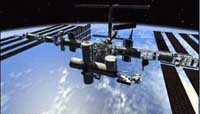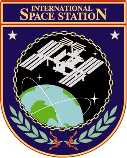 Sixteen nations are building an International Space Station in Earth orbit. It will be occupied in the early 2000s. Billed as the most ambitious space program in history, the station will replace the world's only orbital laboratory, Russia's aging Mir station, which was in space from 1986-2001.
Sixteen nations are building an International Space Station in Earth orbit. It will be occupied in the early 2000s. Billed as the most ambitious space program in history, the station will replace the world's only orbital laboratory, Russia's aging Mir station, which was in space from 1986-2001.
The project, which may change the course of human history, entails nothing less than building a city in space. It is the largest international civil science and technology project ever undertaken. All sixteen nations cooperating in designing and developing the station will operate and use it.
The partners are the United States, Russia, Sweden, Switzerland, Japan and the members of the European Space Agency including Canada, Belgium, Denmark, France, Germany, Italy, Netherlands, Norway, Spain and the United Kingdom.
American Modules. The United States modules for the International Space Station are being launched through 2006.
More than 80,000 pounds of flight hardware have been manufactured and the exterior structures of the U.S. components have been completed.
Unity, the first U.S.-manufactured Space Station module to fly, was launched from Kennedy Space Center in 1998. The U.S. has contributed the first station laboratory, the U.S. Laboratory Module named Destiny, launched in 2001. The U.S. habitat module, where astronauts will eat and sleep, will be among the last pieces to be launched to the International Space Station.
The laboratory and habitat modules each are 28 feet long and 14 feet in diameter. The two connecting node modules are the same diameter, but 10 feet shorter. There also is an airlock module where astronauts will suit up before venturing out for spacewalks.
NASA's international partners are contributing hardware. For instance, the Russian-built Functional Cargo Block (FGB) and the Italian Leonardo module.
 European Docks. Europe is building two docking modules for the International Space Station. The latter of the two docks is in exchange for the planned NASA launch of the station's ESA-supplied Columbus laboratory module.
European Docks. Europe is building two docking modules for the International Space Station. The latter of the two docks is in exchange for the planned NASA launch of the station's ESA-supplied Columbus laboratory module.
This kind of launch-offset barter agreement is common within the International Space Station program. Through this agreement, ESA uses node construction services as payment to NASA for the launch of the Columbus module. Then, ESA will supply Node 2, a dock connected to the U.S. Laboratory Module.
Node 3 will attach to the station's habitation module and provide valuable additional docking ports for the orbital outpost. European construction of the two nodes has been delegated to the Italian Space Agency.
Although the construction of the two nodes by ESA is the primary service supplied to NASA under the barter agreement, the agreement also includes requirements for ESA to supply a crew refrigerator/freezer unit for the station's habitation module, a cryogenic freezer unit for the U.S. laboratory module, and a variety of other minor hardware.
Russian Functional Cargo Block. The U.S.-funded, Russian-built FGB is an element of the International Space Station.
The Russian Service Module is the first fully-Russian contribution to the station. The European Space Agency is contributing the Columbus Orbital Facility and there will be a third connecting module called Node 3.
Learn more about the International Space Station:
- "Looking Out From the Stars" in the May 28, 1998, edition of the award-winning Christian Science Monitor daily website.
International Space Station modules to be launched